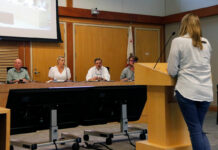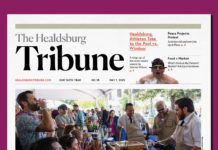After Thanksgiving dinner at my brother-in-law’s, the conversation turned to politics. It had been proposed earlier in the day by someone who doesn’t particularly like a ruckus that this year we avoid talking about politics. It’s not as if someone says, OK, we are now going to talk about politics. Around the table were extended families members from Amador County (where we gathered), Sonoma County, Kern County, and Shasta County. We were talking about how disparate parts of California see themselves and each, about sports, schools, the environment, agriculture, jobs, churches. Having gotten that far down the road, the next step into politics was probably inevitable. My brother-in-law said, “No offense, Marvin, but the religious right scare the bleep out of me.” Someone else said, “Marvin’s not that conservative.” He said, “He is about some things.” The other person said, “He’s liberal about some things.” I didn’t have to say anything, and so I didn’t. The conversation continued on its way without me.
As I listened, I mused about politics and religions. What and who is the religious right that scares my brother-in-law? One answer is that it’s traditional Catholics and conservative Evangelical who are opposed to abortion and same sex marriage. Most people do consider those views right wing. On the other hand many of the same traditional Catholics, including the US Conference of Catholic Bishops, support generous immigration reform and a foreign policy that chooses diplomacy over military force. Evangelical individuals and congregations are in the forefront of service to the homeless and the hungry and the treatment and prevention of HIV/AIDS, especially in the Third World. These latter views, which often lead Catholics and Evangelicals to engage politically, are not generally considered to be right wing.
I also mused about what I call the religious left who scared the bleep out of lots of Americans. The civil rights and anti-war movements of the 60’s and 70’s were in large part motivated and organized by religious leaders and committed laity. Among the clergy were the Berrigan brothers, both Catholic priests, William Sloane Coffin, the pastor of the Riverside Church in New York City, and, of course, Martin Luther King, Jr. King’s commitment to non-violence was based on a very conservative, one might even say fundamental interpretation of Jesus’ Sermon on the Mount and of his sacrificial death on the Cross. Nevertheless, both the civil rights and the anti-war movements were generally considered to be left wing. The pastors of the Methodist Church I grew up in and the Episcopal Church where I was confirmed as a teenager both went to Selma, Alabama, to witness for racial equality and lost church members because of it. My wife Bonnie and I participated in the march on the Pentagon in 1967 when we were both students. The first group in the march formation was “Notables”, which included such strange bedfellows as Norman Mailer and Dr. Benjamin Spock. The second group, Group B, was “Religious.” Our sign read “B Religious”, which could be read both as an identifier and an exhortation. The “B Religious” group included tens of thousands of priests, ministers, rabbis, monks, nuns, and seminarians. We were expressing moral commitments based on religious beliefs in the political arena.
That is what and who the religious right and left were and are: citizens who are expressing and advocating for moral commitments based on religious beliefs in the political arena. Is this a good thing? Absolutely. Is this an American thing? Absolutely. Is this something the Founders expected and intended? Absolutely. It is clear from speeches, articles and correspondence, that the Founders, including those who weren’t traditionally religious themselves, believed that moral principles based on religious belief and observance where necessary to the formation of a people capable of self governance. What about the separation of church and state? The first amendment of the U.S. Constitution states that Congress shall make no law respecting an establishment of religion; or prohibiting the free exercise thereof. What the anti-establishment clause prohibits is a national established or state church such as the Church of England. When the Constitution was adopted, a number of states had established churches. The original interpretation and application was that the amendment applied only to the federal government and that states that wished to could continue to have established churches. The free exercise clause was the more fundamental. Citizens were allowed and expected to bring their religious beliefs and the moral values based on those beliefs into the “public square.”
The recently released movie, “Lincoln” invites us to enter imaginatively into the moment in our history in which religion and politics were inextricably bound together. Religious arguments were made on both sides of slavery, emancipation, and the preservation of the Union. Lincoln engaged in subtle and complex political maneuvering. He also believed that Divine Providence was a work in both moral achievement and just punishment. In his second inaugural address, when the end of the Civil War appeared to be approaching, Lincoln said that both sides in the war read the same Bible and prayed to the same God. But, he went on to say, the prayers of both sides could not be answered and that neither was answered fully. Even as he hoped and prayed for the end of the war he said, “The Almighty has His own purposes… If God will that (the war) continue until all the wealth piled by the bondsman’s two hundred and fifty years of unrequited toil shall be sunk, and until every drop of blood drawn with the lash shall be paid by another drawn by the sword, as was said three thousand years ago, so still it must be said, ‘ the judgements of the Lord are true and righteous altogether.’“
I hope and pray that this nation will continue to be blessed by religious citizens — left, right and center — who bring their moral convictions into the political arena “with firmness in the right” as Lincoln said, “as God gives us to see the right.”
Canon Marvin Bowers is a retired clergyman and may be reached at fr************@***il.com.







